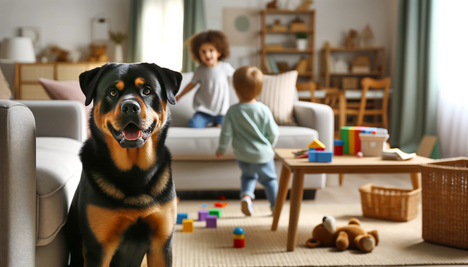Attribute "Not child-friendly"

Attention, Stormy Dogs: What "Not Child-Friendly" Means for Dog Breeds
Dogs are wonderful companions that enrich our lives in many ways. But not every dog breed is suitable for every life situation. If you have children or are planning to have children in the near future, it is particularly important to know which dogs are considered "not child-friendly". In this article, we'll clarify what this characteristic means, why certain dogs are not considered child-friendly and how you can make the best decision for your family.
What does "not child-friendly" mean?
The term "not child friendly" refers to dogs that tend not to get along well with children. This does not mean that these dogs are aggressive or dislike children, but that they may have a lower tolerance threshold or special needs that make it difficult to have them live safely and harmoniously with children.
Typical characteristics of non-child friendly dogs
- Low stimulus threshold: Dogs that quickly become stressed or anxious when there is a lot of noise or sudden movement around them.
- Protective instinct: Some dogs have a strong protective instinct that can cause them to perceive strangers, including children, as a threat.
- Size and strength: Very large or strong dogs can accidentally knock over or injure small children, even if they are just playing.
- Independent nature: Dogs that are very independent and have little interest in social interaction may be overwhelmed with the constant interactions and playfulness of children.
Why Are Some Dog Breeds Not Child Friendly?
There are several reasons why certain dog breeds are not considered child-friendly. These reasons can be genetic or due to individual experiences and training methods.
Genetic predisposition
Some dog breeds were originally bred for tasks that did not require close interaction with people, especially children. For example, guard dogs were trained to be alert and sometimes suspicious of strangers. These innate behaviors can make it difficult to acclimate them to the chaotic and often unpredictable nature of children.
Lack of socialization
Dogs that have not been adequately socialized in their first few months of life may have difficulty adapting to new situations and people. Inadequate socialization may cause the dog to react fearfully or aggressively when confronted with children.
Bad experiences
Dogs that have had bad experiences with children may develop a lasting distrust or even fear. These dogs may react negatively to children, even if they are well behaved and friendly.
How can you recognize a dog that is not child-friendly?
It's important to do your research and educate yourself before getting a dog. Here are some steps you can take to make sure the dog you choose is right for your family situation:
- Breed research: Thoroughly research the characteristics of the dog breeds you are interested in. Pay attention to both positive and negative characteristics.
- Visits to shelters or breeders: Talk to shelter staff or breeders who know the dogs well and ask specifically about their behavior towards children.
- Trial homes: Some shelters offer the opportunity to adopt a dog on a trial basis to see how it behaves in your family.
- Behavioral observations: Pay attention to the dog's behavior in different situations, especially around children. A good indicator of child-friendliness is relaxed and friendly behavior.
Dealing with a non-child-friendly dog
If you already have a dog that doesn't get along well with children, there are ways to manage the situation and make living together safe and enjoyable.
Training and socialization
A dog trainer can help you to better prepare your dog for dealing with children. Through targeted training and positive reinforcement, the dog can learn to feel more comfortable around children.
Safe space
Make sure your dog has a safe place to retreat to if he feels overwhelmed. This place should be off-limits to children so that the dog knows it will not be disturbed.
Clear rules
Explain to your children how they should behave around the dog. This includes rules such as "Do not disturb when the dog is eating or sleeping" and "Do not pull the tail".
Final word
Not every dog is suited to living with children, and that's perfectly fine. The most important thing is to understand the dog's needs and behavior and make sure that both the dog and the children live in a safe and loving environment.

